




Return To Catalogue - Other German States - Germany local issues (before 1900) Bergedorf
Note: on my website many of the
pictures can not be seen! They are of course present in the cd's;
contact me if you want to purchase them: evert@klaseboer.com.
One of the German States. This German
city was conquered by Hamburg and Lubeck in 1420. They governed
it together until 1867, when it became the property of Hamburg. It was 90 square kilometers
large and had 12,198 inhabitants in 1861.
5 stamps were issued in 1861, all with different sizes, showing
the arms of Hamburg and Lubeck (divided in two halves). The
letters LHPA in the design stand for Lubeck Hamburg Post Amt. On
1 January 1868 the stamps of Bergedorf were no longer valid, the
stamps of the North German Federation
were used instead.

1/2 Schilling black on blue 1 Schilling black on white 1 1/2 Schilling black on yellow 3 Schillinge blue on red 4 Schillinge black on brown
Value of the stamps |
|||
vc = very common c = common * = not so common ** = uncommon |
*** = very uncommon R = rare RR = very rare RRR = extremely rare |
||
| Value | Unused | Used | Remarks |
| 1/2 s | *** | RRR | 200,000 stamps printed. 161,000 were used and the
remainders (39,000) sold to Moens. I've seen an essay in blue color. |
| 1 s | *** | RR | 90,000 stamps printed. 64,000 were used and the
remainders (26,000) sold to Moens. I've seen an essay in green color. |
| 1 1/2 s | * | RRR | Inscription should be 'SCHILLING' and not 'SCHILLINGE'! 100,000 stamps printed. 32,000 were used and the remainders (68,000) sold to Moens |
| 3 s | ** | RRR | 80,000 stamps printed, 37,000 were used and the remainders (43,000) sold to Moens |
| 4 s | ** | RRR | 80,000 stamps printed, 30,000 were used and the remainders (50,000) sold to Moens |
| All reprints | vc | - | |
Source for the number of stamps printed as
mentioned above: 'The Stamps of the German States' by
B.W.H.Poole.
The remainders were bought by a stamp dealer of Brussels (Moens)
in 1867 (300,000 stamps). This accounts for the fact that mint
stamps are much cheaper than used stamps. By the way, Moens also
made enormous amounts of reprints of these stamps (see there).
Tete-beche stamps exist of the values 1 s and 1 1/2 s:
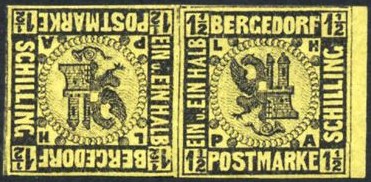
(I've been told that these tete-beche stamps of the 1 1/2 s value
are genuine)
According to the Michel Spezial Katalog, the stamp dealer Moens is known to have made 'proofs' of two 1 1/2 Sch stamps, in which one stamp has the inscription 'SCHILLING' and the other 'SCHILLINGE'. However, other sources (Ewald Muller-Mark) say that the stamps were discovered in 1869, before even Moens reported them. He claims it is a printer proof (see also 'Fakes & Forgeries of Germany & Colonies, No2, 1966, page 90-91 for a translation of Muller-Mark's article in English).

Vertical tete-beche 1 s stamps
Cancels, example:

(Genuine stamp with genuine typical cancel)
The cancel used in Bergedorf consists of a square of five equi-distant lines. Sometimes the cancel was applied twice, in which the second strike was applied turned (such that a cancel as shown above appeared or even a pattern of squares).
Many forged cancels exist.

Essay-reprint in a different design (4 Sch). The original essay
appeared in 1866 as it was believed that the 4 Sch stamp had been
forged in Hamburg. It exists in at least eight different colors
(source: 'The Stamps of the German States' by B.W.H.Poole).

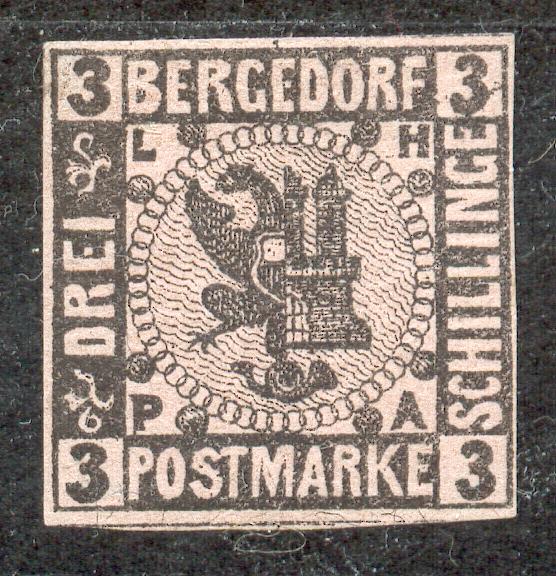
Reprints of the rare non-issued stamps made on the order of Moens
by the Bergedorf authorities. The bar in the 'H' of 'SCHILLING'
is very defective (or even missing) in the 1/2 Sch reprint. The 3
Sch reprint has two black dots in the 'S' of 'POSTMARKE'.
The stamps 1/2 Schilling black on lilac and 3 Schillinge black on red were printed but came never into use (see pictures of reprints of these stamps above). The full story on these 'official imiations' can be found in 'The Stamps of the German States' by B.W.H.Poole.

Reprints of Bergedorf
ATTENTION: most of the stamps of Bergedorf found today are reprints (though forgeries also exist). Mr. Moens of Brussels obtained the lithographic stones of Bergedorf and made reprints in 1872, 1874, 1887 and 1888 (according to: 'Philatelic forgers, their lives and works' by V.E. Tyler). He gave the printing stones of the Bergedorf stamps to the Berlin Postal Museum (Reichpostmuseum) in 1894 (source: http://www.berliner-philatelisten-klub-1888.de/hist.htm). According to 'The Stamps of the German States' by B.W.H.Poole, Moens also possesed the cancelling device of Bergedorf, which was also given to the Berlin Postal Museum.
'The Forged Stamps of all Countries' by J.Dorn says that the reprints have many broken lines in the wavy background pattern and the crossbars of the 'A' and 'H' partially or completely missing. The following distinguishing characteristics are given by my 1925 Scott catalogue, the book 'Distinghuishing Characteristics of Classic Stamps, Old German States' by Herman Schloss and this website http://www.philaforum.com/briefmarken/forum/thema6454.htm; concerning these reprints.
1/2 Schilling


Reprints of 1872 (left) and 1887 (right)
The reprints of the 1/2 Sch has the upper part of the shield
blank. The upper part of the right hand side of the 'N' of 'EIN'
has a dot. The horizontal bar in 'H' of 'HALBER' is often broken.
Specialists distinguish between the 1872 reprint and the 1887
reprint. In the 1887 reprint the eagle head is very faded (see
image above).
1 Schilling


(reprints, note the thick '1's in the corners in the second
stamp)
The reprints have a broken horizontal bar in the 'A' of
'POSTMARKE'. In the corners, the '1' generally has a foot. There
is a black line between the horizontal central bar of the 'E' of
'EIN' and the vertical bar of this letter. Generally, the
horizontal bar of 'H' of 'SCHILLING' has two black lines
seperating it from the vertical bars. A second reprint was made
with very thick ugly '1's in the corners. Specialists distinguish
between 1872, 1887 and 1888 reprints. The 1887 reprint has the
very thick '1's as shown above. The 1888 reprint has the
background lines printed very weak.
1 1/2 Schilling

(Even tete-beche stamps were reprinted)
The reprints of the 1 1/2 Sch were made from essays, not from the actual plates used for postage stamps. They always have the inscription SCHILLINGE (with final 'e') which is an easy test. There is also a small black triangle under the towers (above the 'R' of 'POSTMARKE'). Specialists distinguish between a 1872 and 1887 reprint.
Note: there exists a se-tenant 1 1/2 Sch with and without
final 'E' (so-called Moens 'Korrekturabzug').
See for more information: http://www.klassische-philatelie.ch/ad/altdeutsch_bdorf_moens.html.
It is most likely a phantasy product of the stamp dealer Moens of
Brussels.
3 Schillinge
In the reprints of this value, the head of the eagle doesn't have any shading. There is a blue line between the horizontal central bar of the second 'E' of 'BERGEDORF' and the vertical bar of this letter. Specialists distinguish between 1872, 1887 and 1888 reprints. A coloured dot can be found in the lower half of the 'S' of 'POSTMARKE' in the 1872 reprint. There is a scratch line in the 'C' of 'SCHILLINGE' in the 1888 reprint.
4 Schillinge
For this reprint, the upper part of the shield is not shaded (or has some very small lines in it). Specialists distinguish between 1872, 1874 and 1887 reprints). Often, there is a diagonal thick scratch in the wavy lines at the right side of 'IE' of 'VIER' (1872 and 1887 reprints). A dot can be found in the lower part of the second 'I' of 'SCHILLING' (for the 1872 and 1887 reprints only). The 'R' and 'G' of 'BERGEDORF' are touching in the 1872 reprint. In the 1874 reprint, the eagle has a 'horn'. The 'P' in the lower left corner has the circle above it quite smudged.
How to detect forgeries? In the genuine stamps there are lines in the upper part of the shield (except for the 1 Sch, which has a blank upper part of the shield). More information on forgeries can be found on Bill Claghorn's forgery site, see: http://www.geocities.com/claghorn1p/Bergedorf/Berg00.htm. The genuine stamps should have a perfect pattern of intertwining circles around the central design. According to 'The Stamps of the German States' by B.W.H.Poole, the earliest forgeries of the stamps of Bergedorf already appeared in 1864.
The genuine 1/2 Sch. stamps can be recognized with:
1. The 'R' of 'HALBER' is broad and flat-topped.
2. The N of EIN does not contain a large dot in its upper right
extremity and the letter is composed of three thick lines.
3. The left tower of the castle is bisected vertically.
4. The cross-bars of all letters A, F and H are intact (or very
nearly so)
5. The paper is blue (there exists a Sperati
forgery on white paper, with the 4 above mentioned
characteristics, see image below).
The genuine 4 Sch has (information obtained from Bill Claghorn's forgery site and 'Distinghuishing Characteristics of Classic Stamps, Old German States' by Herman Schloss):
1. A dot in the middle of the 'E' of 'POSTMARKE'
2. There is also a dot below the 'P' of 'POSTMARKE' (below the
frameline)
3. The shading on the griffin's head is uniformly done

Forgery of a reprint? The inscription is 'SCHILLINGE', but the
white part of the shield is much smaller than in the above
reprints.
Forgeries with irregular circles:
The above forgeries of the 1/2 sch, 1 sch, 1 1/2 sch, 3 sch and 4 sch have the circular pattern very irregular.

Forgery of the 1 Sch stamp with the circular chain pattern not
touching the label with 'BERGEDORF'. Also note the blotchy
printing and the very clumsy '1's in the corners.

Another forgery of the 1/2 s

I have my strong doubts about the above tete-beche stamps, could these be forgeries?

Forgery of the 1 1/2 Sch with correct inscription 'SCHILLING'.
In the above stamp, the '3's are much larger than in the genuine stamps. The circular chain pattern is also very irregular. The head of the eagle is almost touching the chain pattern above it.

In this forgery of the 3 s, the '3's are much too thin.

A 3 Sch forgery with different ornaments above and below the word
'DREI'; also the cancel looks like a phantasy cancel (some kind
of flower?).
In the two forgeries above of the 4 s, the chain pattern has not as many chains as the genuine stamp. Note that the round window in the lower part of the tower seems to be absent.

In this forgery of the 4 s value, the chain pattern is very
irregular
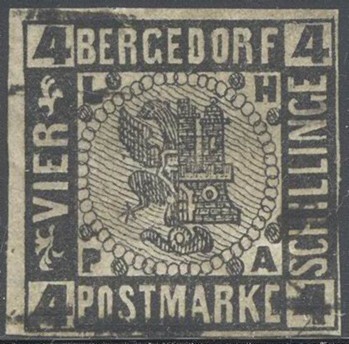
A forgery of the 4 Sch value with almost straight lines instead
of wavy lines in the background.
The forger Peter Winter also made forgeries of these stamps. I know that he made forgeries of the values 1/2 s, 1 s (pair), 1 1/2 s (pair with one stamps with final 'E' and without), 1 1/2 s (tete beche pair), 3 s, 4 s and 3+4 s together on piece.


1 1/2 s tete-beche pair, with 'replik' printed on the backside

1/2 s Peter Winter forgery with "RATZEBURG" cancel as
found in the House of Stamps catalogue.
Winter forgeries also exist with "BERGEDORF" cancels with several dates "2/11 V" or "8 2 V". Also with the rare Hamburg Butterfly cancel ('Schmetterlingstempel').



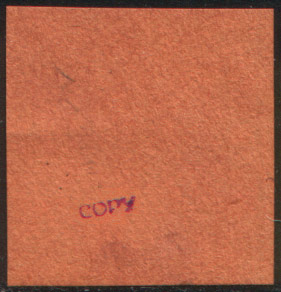
I've been told that these forgeries were also made by Peter
Winter, they have the inscription 'COPY' on the backside
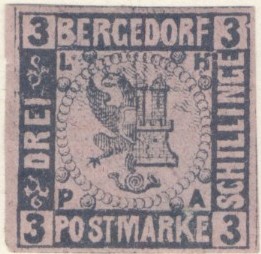


Very dubious 3 Sch stamps, probably all forgeries.

Forgery of the 3 Sch with the wavy background pattern much too
coarse.

1/2 Sch forgery made from a photograph of a genuine stamp. One
can see the typical 'photgraphical dots' on this reproduction.

A forgery of the 3 Sch with the central circular design not
touching the bottom and top inscription labels. Also note the
bogus cancel.
I know that the forger Julius Goldner (Hamburg, Germany) made forgeries of the Bergedorf stamps (see 'Philatelic Forgers, their Lives and Works' by Varro E. Tyler). I have no further information. If anyone has more information, please contact me!
![]()
The forger Fournier made the above
forged cancel 'BERGEDORF 7 AUG.63' in a box (reduced size). I do
not know where he used this cancel for. The above cancel was
taken from a 'Fournier Album of Philatelic Forgeries'.
For Germany local issues (before 1900) of Bergedorf, click here.